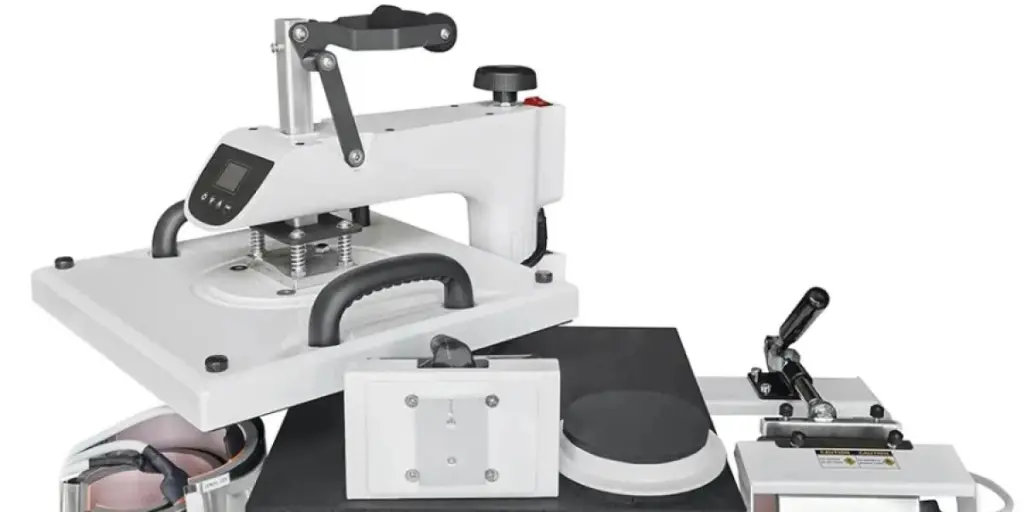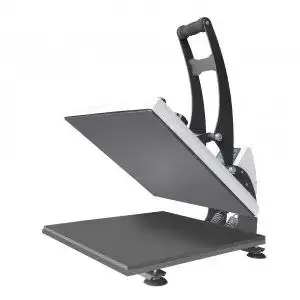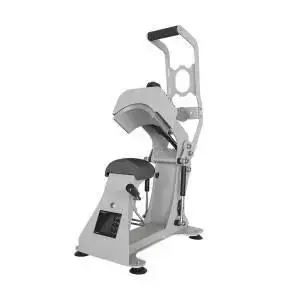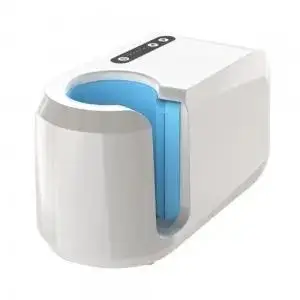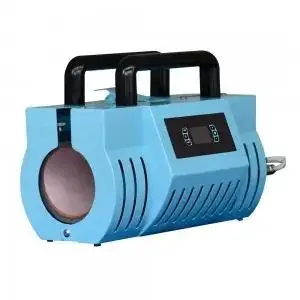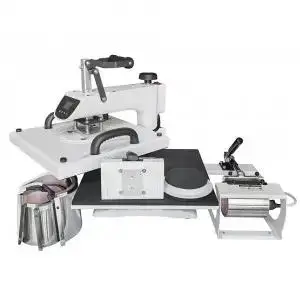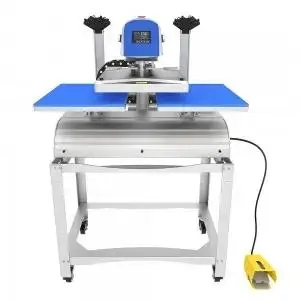A heat press is a machine engineered to imprint a design or graphic onto a substrate surface, such as onto a t-shirt, sublimation mug, or hat. The heat press achieves the print through the application of heat and pressure for a preset period of time.
To use a heat press, the user must select the desired settings and then accurately position the transfer design on top of the substrate surface. The heat press is then closed, which transfers the design onto the material. Heat presses provide exact time and temperature settings with even and constant pressure to complete the sublimation, or heat transferring, process.
Before using a heat press machine, users must understand how they work and know which settings are best for each surface type. In this article, a brief overview on heat press machines is provided, as well as some tips on their usage. Not so long ago, heat press machines were only used in a commercial setting. However, with the increase in home dyeing and cutting machines, heat press machines are now available for home and small business use.
When choosing a heat press machine, consider these variables: the available printing area, the type of application and materials, temperature range, and manual vs automatic settings.
Read on to learn how to choose the best heat press machine for your purpose.
How we chose the best heat press machines:
After exploring dozens of heat press machines, we considered several criteria to narrow down our list of top picks. The top models in our list are well-made and designed to apply either HTV or sublimation ink effectively. We based our choices on brand reputation as well as each machine’s durability, performance, and price.
Types of heat press machines:
To help with the selection process, the following list features some of the most recommended heat presses in an array of types and sizes, and at various price points. Heat press machines often look similar, however, they each have unique features for their specialties. Before purchasing a heat press machine, consider the different types available and pinpoint what particular tasks you will need it to complete. The basic types of heat press machines based on their features and specialty are as follows:
Clamshell (CraftPro basic heat press)
The clamshell heat press is a popular choice among both beginners and professionals, due to its simple operation and small size. The clamshell gets its name from the hinge located between its upper and lower plates, as it opens and closes in a similar way to a clam shell. This heat transfer machine is ideal for printing designs on thin, flat surfaces like T-shirts, tote bags, and sweatshirts. However, the clamshell style is not suitable for transferring designs on thick materials, since it is unable to distribute the pressure evenly over the plate’s surface.
Swing Away (swing-away pro heat press)
Swing away heat press machines, also known as “swingers,” are characterized by a swinging top, where the top of the machine is able to swing away from the bottom platen to allow for better positioning of the item. Unlike the clamshell press, the swing away press works on thicker materials, such as ceramic tiles and MDF board. However, this style takes up more space and is more expensive than the clamshell model.
Drawer (auto-open & drawer heat press )
On a drawer heat press machine, a lower platen pulls out toward the user to allow for the garment to be laid out in full and for the entire space to be viewed. These machines not only enable the user to quickly reposition garments and graphics, but they also provide a larger heat-free area to avoid scalding. However, the drawer heat press machine requires more floor space and is more expensive than clamshell and swing style heat transferring machines.
Portable (portable heat press mini)
Portable heat press machines are ideal for hobby crafters who are interested in DIY garments but do not wish to make a large investment. These lightweight machines are designed for small-scale heat transfer vinyl (HTV) and dye sublimation transfers onto the likes of T-shirts and tote bags. It is more difficult to apply pressure evenly with a portable heat press machine, but they are an affordable, quick way to get started in the heat press transfers business.
Combo and multipurpose (multi-purpose heat press 8-in-1 (8in1))
Combo and multipurpose heat press machines allow users to add custom designs to hats, cups, and other non-flat surfaces. Many heat press machines are designed for one single purpose, such as creating a custom mug or hat business, however, multipurpose machines have attachments that can be swapped out to handle other items, including non-flat surfaces. The most popular is the 8-in-1 heat press machine, measuring 15”x15”.
Semi-automatic (semi-auto heat press)
Semi-automatic heat press machines are the most popular type on the market. They require the operator to set the pressure and manually close the press, however, once the timer finishes, the heat press automatically pops up. This type of press offers ease of use without the cost of a pneumatic press.
Pneumatic (pneumatic heat press)
Pneumatic heat press machines use a compressor to automatically apply the correct pressure and time. This type of heat press is often more expensive, but it offers greater precision and consistency. Additionally, pneumatic heat presses can be used with a wider range of materials than other heat press machines, making them an ideal choice for many applications. Pneumatic heat press machines are usually the top choice for professionals, and they are especially recommended for bulk T-shirts printing businesses.
Electric (electric heat press)
Electric heat press machines use an electric motor to automatically apply the correct amount of pressure and time. These heat presses are more expensive than pneumatic heat presses, but they offer more precision and consistency. Moreover, electric heat presses do not require an air compressor, meaning the overall cost becomes similar to that of a pneumatic heat press with its air compressor. Additionally, electric heat presses can be used with a wider range of materials, making them an ideal choice for various applications, and especially recommended for bulk T-shirt printing businesses.
Factors to consider when choosing the best heat press machine:
Choosing the best heat press machine depends primarily on the material. Additionally, factors such as budget, portability, and efficiency should be considered. When choosing the best heat press machine for your purpose, consider:
Size
A heat press machine’s platen size determines the size of the design that can be used. A larger platen therefore provides greater flexibility. The standard platen sizes are 5”x5”, 9”x9”, 9”x12”, 12”x15”, 15”x15”, 16”x20”, 16”x24” and large formats.
Custom platens are also available in different shapes and sizes to transfer designs onto shoes, bags, cap bills, and more. These platens are used for specialty or multipurpose machines and range in size and shape, depending on the machine.
Temperature
Accurate temperature is key to a durable heat transfer application. When considering which heat press machine to buy, note the type of temperature gauge it has and its maximum temperature. Some applications require heat of up to 400 degrees Fahrenheit, however, a heat press temperature of 232C/450F is suitable for 99% of sublimation or transfer jobs.
A quality heat press will have its heating elements evenly spaced, no more than 2 inches apart, to ensure even heating. Thinner platens are less expensive but lose heat much more quickly than thicker platens. Look for machines with, at minimum, ¾ inch thick platens. Although thicker platens take longer to heat, they hold temperature much better.
Manual vs. Automatic
Heat presses come in both manual and automatic models. Manual versions require physical force to open and close the press, while an automatic press uses a timer function to open and close. Semi-automatic models, a hybrid of the two, are also available.
Automatic and semi-automatic models are better suited for high production environments because they require less physical force, thus causing less fatigue. However, they are more expensive than manual units.
How to create a quality print with your heat press:
Picking the right heat press depends on the type of items it will be customizing, the size of the surface area, and the frequency with which it will be used. The best quality heat press machine has the ability to heat evenly and apply consistent pressure across the transfer, as well as having built-in safety features.
Despite their differences, making a quality print on any heat press machine requires the same steps:
- Choose the right heat transfer paper to match the heat setting on the press.
- Use quality ink, remembering that sublimation transfers require sublimation ink.
- Set the heat press controls.
- Lay out the item to be pressed, eliminating creases and wrinkles.
- Position the transfer on the item.
- Close the heat press.
- Use the correct amount of time.
- Open, and remove the transfer paper.
- Close for one more press to secure the print.
FAQs
Choosing the best heat press machines for home or small business use can be complicated, so some questions may remain. Find answers to some of the most frequently asked questions about heat press machines below.
Q. What does “heat transfer” mean?
Heat transfer printing is also known as “digital transfer.” The process involves printing a custom logo or design onto transfer paper and then thermally transferring it to a substrate using heat and pressure.
Q. What can I make with a heat press machine?
A heat press machine allows the user to customize T-shirts, mugs, hats, tote bags, mouse pads, or any material that fits the heat machine’s plates.
Q. Is a heat press a good investment?
A heat press is a good investment for those who plan to customize many objects. For hobbyists, it may be wise to invest in a smaller heat press before moving on to a commercial grade press.
Q. How do I set up a heat press machine?
Most heat presses are simple to use, with a simple “plug in and go” set up. Many even have user-friendly digital displays that make it extra easy to get started.
Q. Do I need a computer for a heat press machine?
Although a computer is not essential for a heat press machine, using one makes it easier to create custom designs and print them onto heat transfer paper.
Q. How do I maintain my heat press machine?
Maintenance for heat press machines varies depending on the machine. Always follow the manufacturer’s instructions for maintenance and care.
Quality printing equipment & garment films
When it comes to printing, a heat press is a great option for businesses of all sizes. This type of machine is versatile and efficient, but it also produces high-quality prints that are resistant to fading and wear. In addition, a heat press is a cost-effective way to produce prints, as it eliminates the need for costly printing equipment and supplies. A wide selection of transfer materials and equipment can be found on Alibaba.com to suit all your heat press needs.
Disclaimer: The information set forth above is provided by Xinhong independently of Alibaba.com. Alibaba.com makes no representation and warranties as to the quality and reliability of the seller and products.
